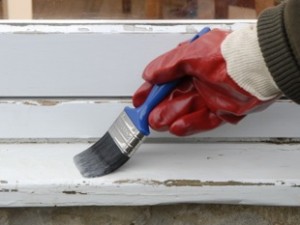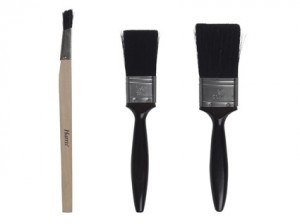Buying paint brushes
Buying paint brushes will almost certainly be an undertaking for every DIY enthusiast, and choosing the right options can often be a little tricky because of the vast array of options on the market. Pure bristle or synthetic? Are cheap brushes OK? Do I need loads of sizes? These are just some of the questions I get asked about the nation’s favourite DIY tool, and to be honest, my advice is fairly straightforward. Below are what I consider to be the most important points when buying paint brushes.
Cheap paint brushes

Cheap paint brushes – perfect for applying paint stripper!
To achieve a good finish you need quality, and I’ve never found a cheap brush that ‘measures up’. Trying to ‘brush out’ or ‘lay off’ paint with a brush that resembles a short goatee beard on a stick, simply doesn’t work. So firstly, bristles must be long and good quality .
But, and it’s a serious ‘but’…..there is a use for cheap brushes, but it’s not for providing a beautiful finish. Cheap brushes are perfect for applying non-finishing products or substances that are so unpleasant they can be difficult to wash out of the brush, with paint stripper and stain blocker being good examples here. In this way you don’t ruin an expensive brush, or need to spend a fortune on cleaning products to try and save it.
Pure bristle or synthetic brushes?
One of the big choices is whether to opt for pure bristle brushes, or their synthetic bristle counterparts. Call me a traditionalist, but I do think that quality pure bristle brushes always provide an excellent finish, so this is where my preference lies. Some of the modern synthetic bristle brushes are still good, clean out beautifully, and I find work well for applying water-based finishes such as emulsion, but I still don’t think anything beats the fine finish of a good quality pure bristle brush.
Paint brush sizes

A fitch, a 38mm brush and a 50mm brush is basically all I need for most painting jobs.
In terms of how many sizes you need, well having every size from 10mm (1/4 in) to 150mm (6 in) is simply not necessary.
The perfect sizes for painting doors and woodwork is 38mm or 50mm (1 1/2 in or 2in), and the perfect size for cutting in emulsion on walls and ceilings is 50mm or 75mm (2in or 3in) – I’d always use a roller for the wide open spaces. The third size I like is something small but not minute – a brush for painting detail – often referred to as a fitch. These have got a long handle and are more like an artist’s brush than a decorator’s, but they’re great for  those small fiddly bits!
The only occasions I feel the need to step up to larger brushes is with aspects of exterior work such as painting some types of wall surface, and areas such as floors, when applying a varnish/oil, or indeed floor paint is a much quicker  job if you use a larger brush.
My paint brush choices
You can buy brushes separately, or, I tend to go for the selection packs – simply because you will always get better value for money. In terms of my favourites, I’d always go for Hamiltons. Most decorators will tell you that the quality of bristle used nowadays is not as good as it once was – whether this is the case or not, I would still say they’re the best ‘go-to’ pure bristle brush. They’re slightly more expensive than much of the competition, but they give a great finish, will last longer than most paint brushes, and are therefore in fact the most cost-effective choice you can make. Well priced Hamilton sets can be found on Amazon, as well as outlets such as Screwfix.
You’ll tend to get some of the smaller brush sizes in the sets available, which although I don’t think are essential size requirements, they’ll still come in useful for the occasional bit of more detailed work. If you’re a beginner, you may also be more comfortable with using the smaller brushes for cutting in on woodwork, but I’d urge you to practise a bit with the slightly larger sizes I suggest, and you’ll actually find that they are the easiest options for painting accurate edges when cutting in.
If you do want to try a synthetic brush, again, the cheap/quality argument still stands firm. My personal favourites in the synthetic world are Purdy Monarch Elites, which you’ll find on Amazon, as well as in more trade-based outlets. I dont use synthetic brushes often, but when I find a paint where the manufacturer insists on using synthetic bristles, a Purdy provides a great finish*.
Fitches can sometimes be tricky to find in DIY outlets, so you may need to visit a trade outlet,or opt for Amazon who have some great selection options.
As far as ‘cheap’ set options go, there’s really no need to be picky, just opt for the ones with the longest bristles on promotion, or on sale, or in the good old bargain bucket!
*Since the time of writing this guide, it is true to say that my hardline approach to preferring pure bristle brushes over synthetic bristles has been challenged a little. The quality of synthetic bristle brushes is certainly on the rise, and with the increased use of more and more water-based paints instead of their traditional oil-based counterparts, I do find myself trying more of the synthetic ranges – for example, check out my guide on Rembrandt angular sash brushes, for further details.
